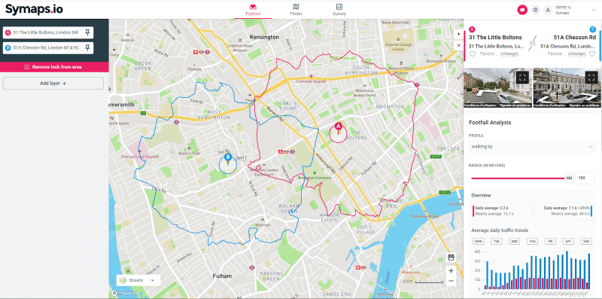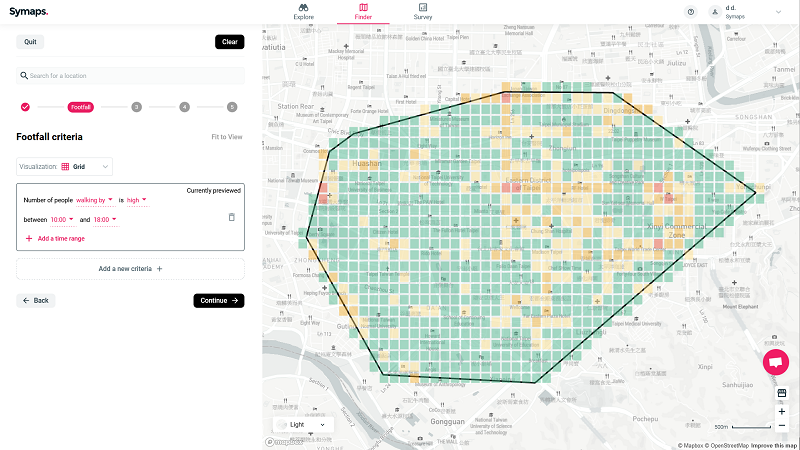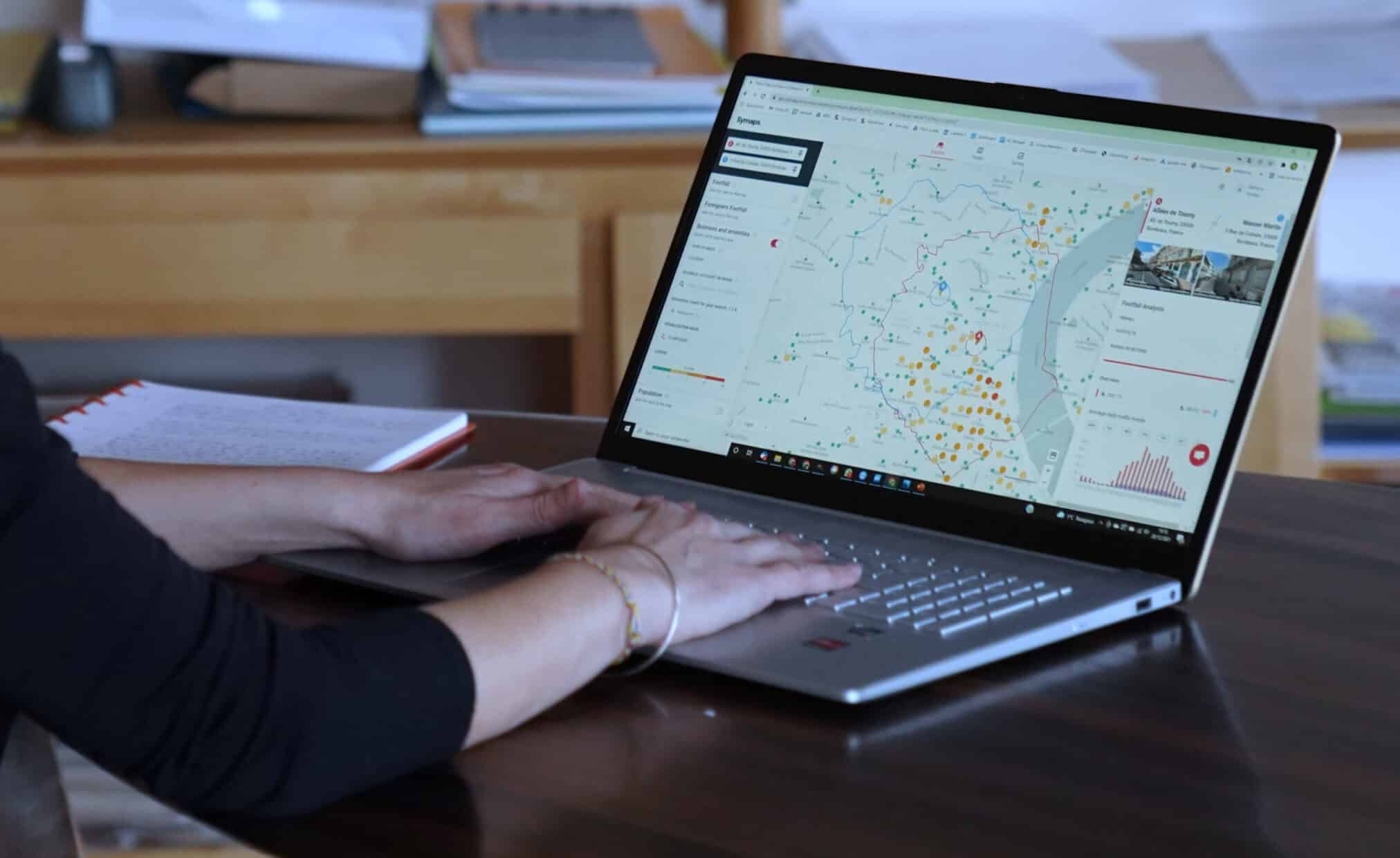Geomarketing: unleash the potential of your network and marketing actions
Technological advancements have allowed businesses to tap into a wealth of data that can be used to inform marketing decisions. Geomarketing is a subset of this data-driven approach and provides valuable insights into consumer behavior and patterns.
However, geomarketing is not just limited to marketing, it can also be used for strategic analysis such as site selection, location planning, and sales network optimization.

1. Geomarketing: Definition
Geomarketing (also known as geographic marketing) is a marketing approach that leverages location data to inform and improve marketing strategies.
The goal is simple—optimize your business’ marketing efforts by targeting the right customers with the right action at the right moment.
To achieve this, geomarketing relies on three core components.
Data Collection (i.e., collecting data)
Gathering data from various sources such as online surveys or customer feedback forms – but more on that later. The goal is to collect enough segmented data to gain a bird’s eye view of the area or location in question.
Data Analysis (i.e., interpreting data to gain insights)
Analysis is where you interpret the data and focus on understanding customer behavior and patterns. This step will help you identify potential customers and areas for improvement, and better understand your target customers.
Action (i.e., leveraging data to inform business strategy, business actions, and decision-making)
Action—the final step in geomarketing—is where you leverage the data and analysis to inform your marketing efforts. This could include personalizing ads or locating the ideal expansion location.
2. Why Use Geomarketing? The benefits of geomarketing
Traditional approaches to marketing are still vital to any successful marketing strategy. But geomarketing offers a number of key advantages over traditional methods that make it well worth considering:
1. Geomarketing Is Highly Targeted
Targeted marketing is efficient marketing. Geomarketing allows businesses to target customers based on their precise location, meaning they can send tailored messages and offers that are more likely to resonate with their target audience.
By ensuring that a message or business model is going to be well-received by a market before entering it, businesses can make the most of their marketing spends.
2. Geomarketing Is Data-Driven
According to a recent study conducted by McKinsey & Company, businesses that define themselves as “data-driven” are 19X more likely to be profitable than similar businesses that do not.
Geomarketing is a data-driven approach to marketing by default. By relying on real-time, hyper-local insights, marketers can make better decisions regarding their campaigns and ensure that they are reaching their desired audiences.
3. Geomarketing Enables Accurate Benchmarking
Geomarketing also helps businesses compare their performance against competitors, existing locations, and the theoretical commercial potential or sales potential of a location. With geomarketing, it is possible to measure the effectiveness of different strategies, compare performance across locations, and get a better understanding of the overall market.
3. Commonly Used Data for Geomarketing (Geodata or Location Data)
Data is the foundation of geomarketing—it’s the raw material that you need to make the most of your marketing efforts.
The following are some of the types of geodata used in geomarketing:
– Sociodemographic data
Information about the characteristics of a population, such as age, gender, income, eductation level, family size,…
Sociodemographic data is often a great predictor of consumer behavior and can be used to identify potential areas of growth.
– Geographic data
Location-based data, such as the physical address of a store or the geographic area of a target audience. It refers to any kind of data that has a geographic or location component.
– Behavioral data
Data on consumer behavior, such as purchasing patterns and website usage. This type of data is especially useful for developing targeted campaigns and understanding customers on a deeper level.
– Social media data
Information from social media platforms, such as Twitter and Facebook.
– Mobile data:
Location-based data from mobile devices, such as GPS and Wi-Fi.
– Sales data
Information about sales, such as the number of products sold or the average transaction value
Analyse your local market and identify areas for expansion with Symaps geomarketing platform!
Symaps is a geomarketing application designed for businesses who are seeking the best locations and strategic insights for their physical expansion.
4. Three Powerful Use Cases for Geomarketing
The potential applications of geomarketing are virtually limitless, making it an essential tool for businesses looking to improve their marketing efforts and drive sales.
Executing Targeted Campaigns
Geomarketing also helps marketers execute targeted campaigns with pinpoint accuracy. By understanding customer behavior and preferences at a given location, marketers can craft campaigns tailored to the needs of a particular market.
Real-time tracking and optimization:
Geomarketing allows businesses to track consumer behavior in real-time and make adjustments to their marketing campaigns accordingly.
Identifying Expansion Opportunities
In addition to targeted marketing campaigns, businesses that use geomarketing tools and geodata can quickly identify potential areas of expansion by analyzing consumer data and identifying areas that have higher commercial potential.
Geomarketing also helps businesses narrow down their search for the perfect potential location by providing detailed insights into:
Existing customer activity
Footfall rates
Competitor density
Primary, secondary, and tertiary zones
Sales network optimization
A good geomarketing application can help businesses assess their current footprint and drive a detailed analysis of their coverage to
– ensure a sufficient number of touchpoints to reach the desired penetration rate
– avoid cannibalisation effects between two touchpoints
– analyze overlaps with competition
etc.
5. Geomarketing tools
There are a variety of geomarketing tools available, including:
– Geolocation tools
Tools that enable businesses to target customers based on their location, such as GPS and Wi-Fi.
– Mapping and visualization tools
Tools that allow businesses to visualize and analyze geographic data, such as heat maps and demographic maps.
– Data analysis tools
Tools that enable businesses to analyze and interpret geodata, such as marketing analytics software and business intelligence tools.
Conclusion
In conclusion, geomarketing offers valuable insights and opportunities for businesses looking to optimize their marketing efforts and drive growth. By leveraging location data, geomarketing enables businesses to understand consumer behavior and preferences, target their marketing campaigns with accuracy, and identify potential areas of expansion.
Potential applications of geomarketing are virtually limitless and the benefits of using this data-driven approach are clear. With the right tools and data, businesses can make informed decisions that lead to better outcomes and increased profitability.
Streamline Your Location Finding Efforts
Site selection – Strategic planning – Coverage analysis – Network optimisation – Expansion simulations – Local market research
Get started today with a free demo and see first-hand how Symaps geomarketing solution can help!
Share post


